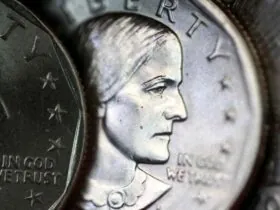In a remarkable archaeological discovery, a piece of Anglo-Saxon jewelry, crafted to imitate a Roman coin, has been declared treasure in the United Kingdom. This rare pendant, found by a metal detectorist near Attleborough, Norfolk, in January 2023, offers a fascinating window into the past, showcasing the cultural influences of the Roman Empire on the pagan Anglo-Saxon people during a time of profound change.
A Glimpse of Roman Influence in Anglo-Saxon Jewelry
This Article Includes
The pendant in question is an imitation of a Roman solidus, a gold coin introduced by the Roman Emperor Constantine in the 4th century A.D. The design on the pendant is modeled after coins issued during the reign of Honorius, the Roman Emperor who ruled the Western Roman Empire from A.D. 393 to 423. What makes this artifact truly unique is that it was crafted during the late 5th to early 6th centuries, a time when the Anglo-Saxons were still pagan, and the Roman Empire had already collapsed in the West.
The obverse of the pendant features a bust of Honorius, wearing a pearl diadem and chest armor, a typical Roman style. On the reverse, a draped figure holding a military flag—known as a standard—represents a Roman symbol of military might, with a small Nike (the Roman goddess of victory) placed at its feet. Interestingly, both the original Roman coins and their Anglo-Saxon imitation include a cross on the standard, a reflection of the Christian influence in the Roman Empire by the time of Honorius’ reign.
Inscriptions: An Insight into Anglo-Saxon Culture

While the imagery is faithfully modeled after Roman coins, the inscription on the pendant is less accurate. The reverse inscription on Roman solidi typically reads “RESTITVTOR REIPVBLICAE,” meaning “Restorer of the Republic.” However, the Anglo-Saxon version is riddled with typos, reading “STITVTOR EIPVBLICAE,” omitting and jumbling certain letters. This linguistic oddity likely stems from the limited writing systems of the Anglo-Saxons during this period.
At the time of the pendant’s creation, the Anglo-Saxons had not yet developed a fully functional alphabet, making the inscription’s errors understandable. For the Anglo-Saxons, these typos may not have been of concern. The pendant was likely crafted not as a coin or an attempt to mimic currency, but as a decorative object, with a gold loop attached for wearability.
More Than Just a Coin Imitation: The Symbolic Purpose of the Pendant
While it’s clear that the pendant is not a direct copy of a Roman coin for functional use, it represents something deeper. The Anglo-Saxons, who had recently settled in what is now England following the fall of the Roman Empire, likely created the piece to evoke a connection with the past. The pendant was a way to symbolize their links to the fallen Roman Empire, an empire that, despite its collapse, still held immense power and significance in the Anglo-Saxons’ collective imagination.
The pendant’s creation was not simply a form of imitation, but an attempt to integrate Roman mythology and legacy into the Anglo-Saxon world. The Roman Empire had already converted to Christianity, yet the Anglo-Saxons remained pagan, creating a fascinating juxtaposition of beliefs, values, and artistic styles. The pendant’s design may represent the Anglo-Saxons’ longing for the grandeur of the past, a time of mythical glory that was now vanishing.
The Significance of the Treasure Declaration
For an artifact to be declared treasure in the U.K., it must be made of gold or silver and be at least 300 years old. The pendant’s gold composition and age, combined with its unique representation of Anglo-Saxon attempts to emulate Roman symbols, earned it the prestigious treasure status. Coin expert Adrian Marsden of Norfolk County Council described the pendant as “unique” due to the blend of cultural influences it represents.
The Anglo-Saxon imitation pendant, while modest in its form, holds great historical value. It is not just a piece of jewelry; it is a symbol of a time when the remnants of the Roman Empire still loomed large in the minds of the people who inherited its lands. This pendant is a tangible reminder of how the Anglo-Saxons sought to connect with a world they could never fully recreate, using art and symbolism to capture the fading echoes of Roman might.
Conclusion: A Link Between Two Eras
The Anglo-Saxon pendant discovered near Attleborough offers a remarkable blend of Roman artistry and Anglo-Saxon craftsmanship. By imitating a Roman coin and infusing it with their own cultural significance, the Anglo-Saxons created a unique piece that bridged the gap between two very different worlds: the fading glory of Rome and the rise of a new, pagan society in England. This fascinating artifact serves as a testament to the ways in which cultures can influence and be influenced by each other, even in times of profound change and transition.
Also Read:







Leave a Reply